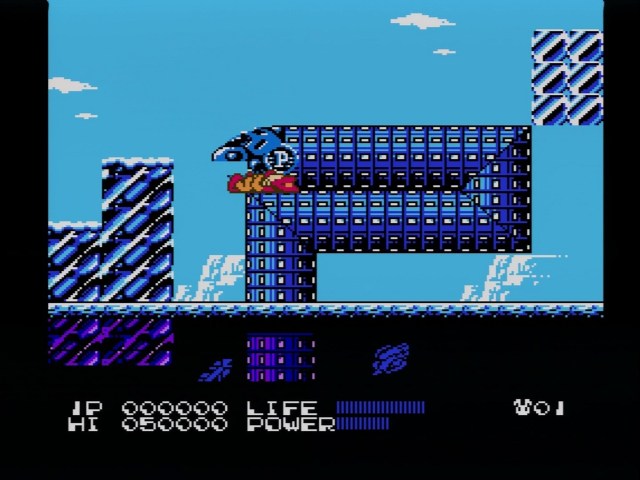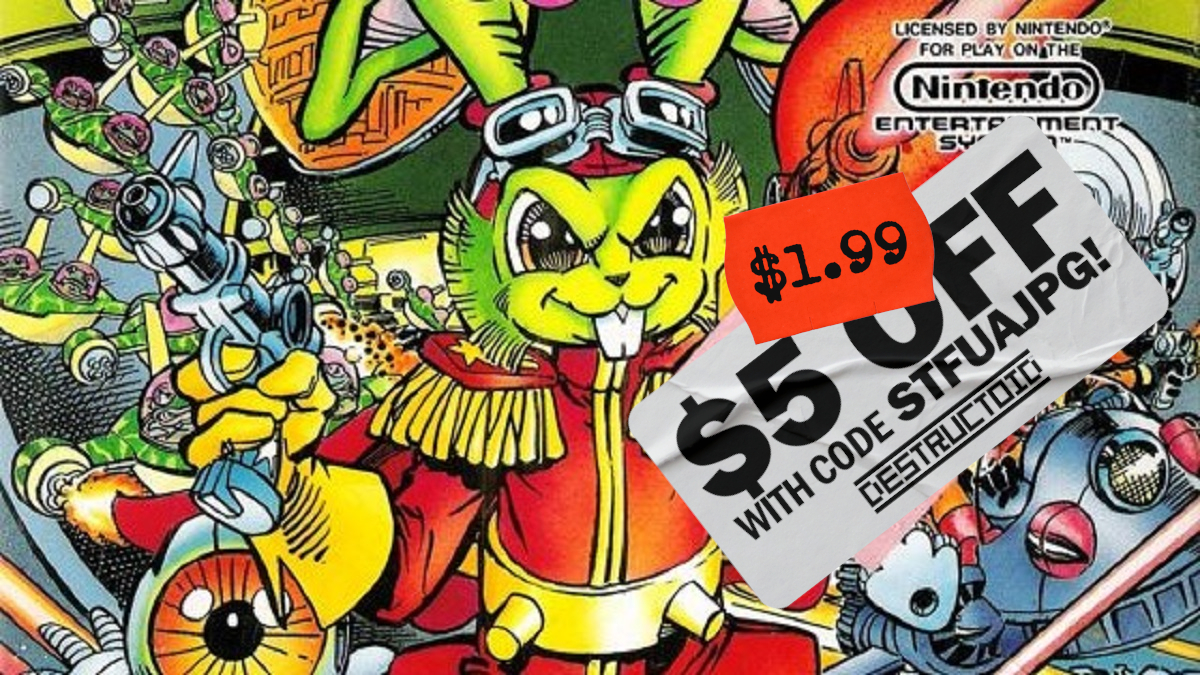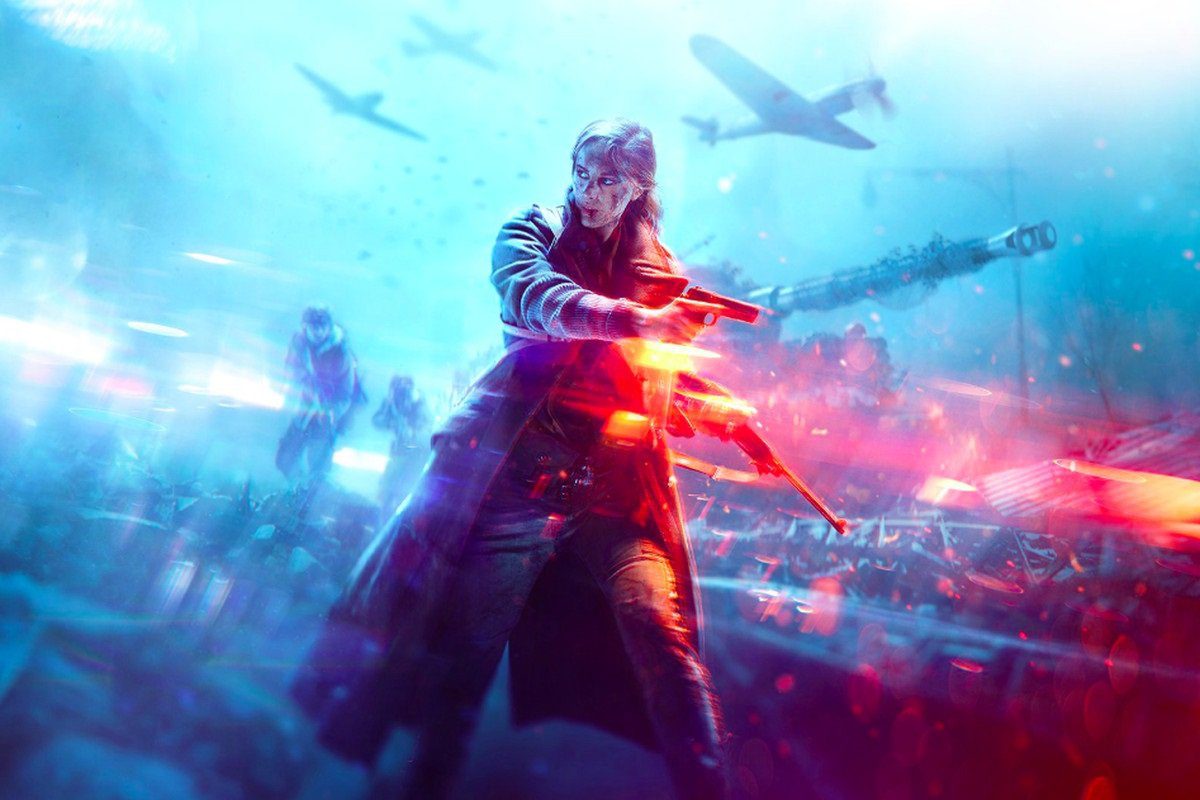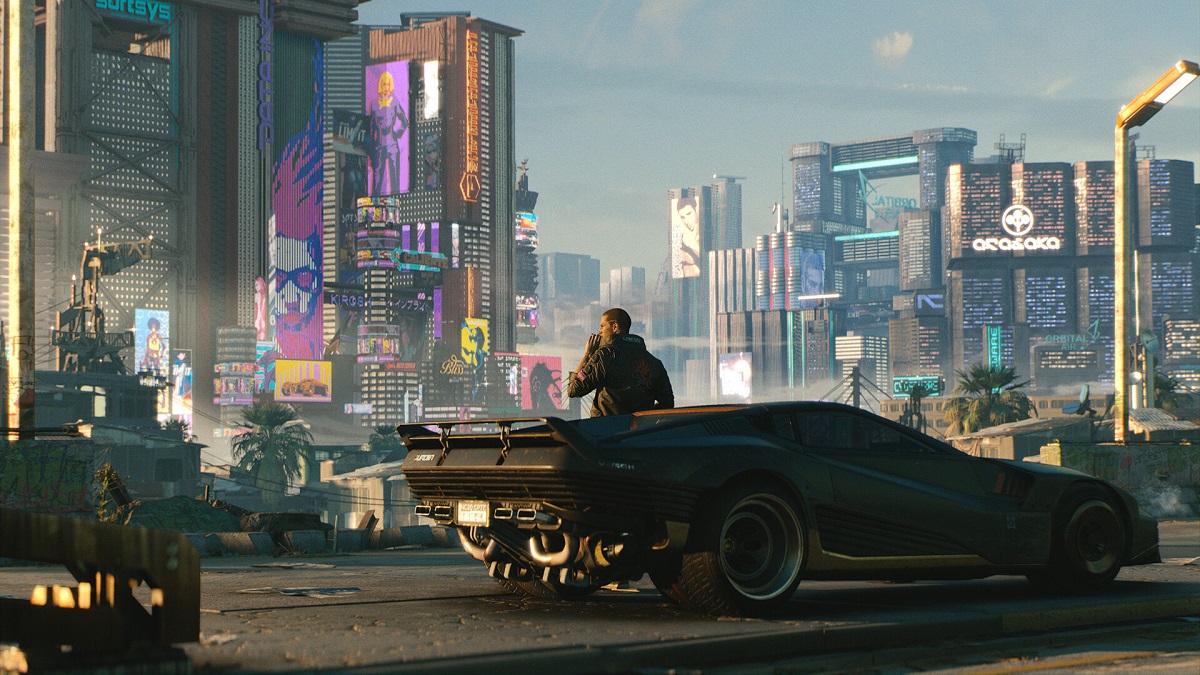I was first introduced to Bucky O’Hare through the NES game. This was back in 2010, long after the cartoon was off the air. It’s an interesting game, which I’ll get to in a bit. However, I quickly grabbed the cartoon to watch and maybe gave up after two episodes. I know that two episodes is a pretty brief amount of time to try and form an opinion on a show, but I couldn’t stand it. It was a horrible maelstrom of bad attempts at wordplay and nauseating self-righteousness.
The ship that the eponymous Bucky pilots is called the Righteous Indignation, which really tells you all you need to know about the show’s tonality.
The cartoon was based on a comic from the late ‘70s, but it’s one of those shows that were pretty obvious in their intention to sell toys. However, it did wind up with a couple of video games by Konami, one for the arcade and the other for the NES. Fortunately, both are a lot more tolerable to me than the cartoon. So let’s look at the NES version.

Terrible wordplay and furry appeal
The Super Famicom was released in 1990 in Japan, followed by the 1991 SNES release in North America. Publishers were quickly abandoning the NES and Famicom in favor of the new platform, but there was still a number of quality games that were released before the last official NES title dropped in 1994.
During the waning years of the NES, Konami, in particular, did a number of mostly licensed titles that were of unusual quality. These were games like Monster in My Pocket, Zen: Intergalactic Ninja, and Bucky O’Hare. None of these were particularly great licenses. None of them really survived the ‘90s. But if you were expecting a crap game to go alongside them, you’re in for a surprise.
I’m not saying that any of these games are great. It’s just they’re a lot better than you’d probably expect. While they do seem somewhat rushed, they all display a level of technique that you don’t find in the era’s licensed games. It’s like an extremely talented development team decided to phone it in.
In the case of 1992’s Bucky O’Hare, that’s exactly what it is. Its director was Masato Maegawa, who went on to found the legendary development studio Treasure.

Quantum kidnapping
If you’re unfamiliar with the premise of Bucky O’Hare, it’s essentially Star Wars with furries. It takes place in an alternate reality nauseatingly called the “Aniverse” because everyone in it is an anthropomorphic animal. The Toad Empire is making life hell for anyone with warm blood. Bucky and his crew are rebels, fighting to free all the mammals from beneath the slimy heel of the Toad Empire. Also, there’s a child insert character who gets transported to this parallel dimension because nothing cements a fantasy in a child’s mind quite like quantum kidnapping.
The game is largely similar to the platforming in the Mega Man series. The crew of the Righteous Indignation is captured by the Toad Empire. Starting out as bucky, you choose from four planets, each with a different member to save. Don’t pick the ice planet, though. You’ll be stuck. You first need to save Blinky from the Green Planet, since he’s the only one who can break ice blocks.
You can sort of see the Treasure DNA in Bucky O’Hare. Each planet has a traditional twist that makes it different (fire, ice, yellow, etc.), but things get changed up pretty frequently in each level. The Yellow Planet, for example, has you riding on meteors one moment before later riding on a cart at processor-meltingly high speeds.
Similar to Zen Intergalactic Ninja and Monster in My Pocket, there’s a lot of programming magic pushing the NES to its limits. Parallax scrolling, huge objects that make clever use of the background layer, gadgets that are made to look like they rotate. There was cooler stuff happening on other platforms at the time, but Bucky O’Hare is a good place to see all the trickery that could be pulled off on the NES.

Croak toads
The downside to this is that the game isn’t great. It’s not bad, and in a lot of ways, it’s better than your typical licensed game. It just isn’t fabulous. I wasn’t that far into Bucky O’Hare before I started wondering why I wasn’t playing Little Samson instead, as that game has a lot of the same concepts but with better execution.
For starters, the characters are very uneven. You can trade them out at any time, but it’s best to just use Bucky unless someone else’s skill is needed for a situation. Everyone has their typical weapon and special ability, but they’re rarely useful. Jenny, for example, has a laser that doesn’t do as much damage as Bucky’s normal shot, but she can also summon an energy sphere that I could never land on a target. The developers probably could have just gotten away with making every character interchangeable so you could play as your favorite, but they went with a half-measure that doesn’t work well.
But the biggest problem is that there’s just so much instant death in the game. There are too many instances where you just touch certain parts of the environment, and your character drops dead. I once momentarily slipped off a log going across some water, and while my character stayed on the raft, they collapsed on the ground because their toe got wet.
The only real punishment for dying is losing any built-up health you have whenever you need to continue, but extending your life bar isn’t that important. You’re most likely going to die from one of the insta-kill hazards, so it doesn’t matter how much life you have. As a result, losing all your lives is just an inconvenience because it sends you back to the beginning of the act you were on.

A buried treasure
The music is at least terrific. It was apparently composed by Tomoko Sumiyama, but I’m not entirely certain about that. They were credited as a sound designer on Laser Invasion and Rampart (the Famicom version), and then I can’t find them having composed anything after 1992. Nonetheless, it’s an enjoyable little bop that fits in with Konami’s other stellar soundtracks.
As a whole, Bucky O’Hare isn’t a great title, but it’s a lot better than you might expect from a licensed title. Especially a license that isn’t that well remembered. I can only assume Konami was hoping that they were scooping up a license that would let them repeat the success of their Teenage Mutant Ninja Turtles games. That plainly wasn’t the case.
For that matter, it also doesn’t feel like a lost Treasure title. While you can see some of the flourishes that would help define Treasure’s later games, it’s overwhelmed by how much it lifts from the Mega Man formula. If you’re already a fan of both Treasure and Mega Man, you might still be let down by how loose and uneven the whole thing is. Instead, go in with the expectations you’d have for an obscure licensed game, and you’ll probably be pleasantly surprised.
For other retro titles you may have missed, click right here!














Published: Sep 1, 2023 8:00 PM UTC